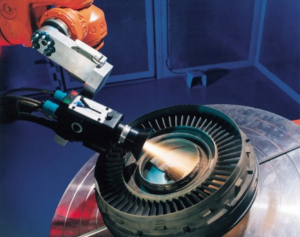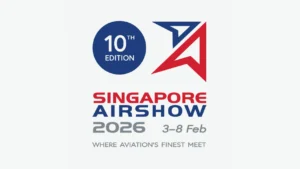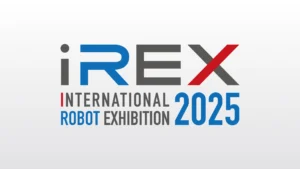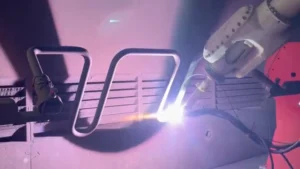table of contents
- Heading 1
- Heading 1
- Heading 1
share this
“Once a new technology rolls over you, if you’re not part of the steamroller, you’re part of the road.” – Stewart Brand
Allow us to begin this article with a heart-lighted – yet heartfelt – piece of advice: don’t be the road when the steamroller is only one demo away! While it is true that robotic automation has already worked magic on thermal spraying productivity, quality, cost reduction, and workplace safety, it is unarguable that making the most of a robotic investment implies fine-tuning it with the latest robotic technologies. In today’s post, we will not only explore the challenges and benefits of robotic thermal spraying in the automotive industry but also get acquainted with the latest scalable solutions that can skyrocket your ROI.
What is thermal spraying?
Before we delve into more complex topics such as robotic thermal spraying or groundbreaking no-code solutions, let’s take a minute to recap what thermal spraying is. Thermal spraying is a surface treatment process that involves heating or melting metallic or ceramic materials and depositing them onto a surface to create a coating. Extensively used in a wide range of industries – such as automotive, aerospace, or manufacturing – thermal spraying ensures corrosion protection, wear resistance, and thermal insulation.
Applications of thermal spraying in the automotive industry
Now, let’s take a closer look at how thermal spraying is used in the automotive industry. One of the main applications of thermal spraying is in the production of engine components. These components, such as cylinder liners, pistons, and valves, need to withstand high temperatures and wear. Thermal spraying provides high-performance coatings that enhance the durability and performance of these engine parts.
Similarly, thermal spraying is used to create coatings that protect automotive parts from corrosion. This is especially important for components that are exposed to harsh environments, such as those found on the underbody of a vehicle. By applying corrosion-resistant coatings, the lifespan of these parts can be extended, reducing the need for maintenance and repairs. And that automatically implies lower car repair bills and happier customers.
Another use of thermal spraying in the automotive industry is in the creation of thermal barrier coatings. These coatings are designed to insulate engine components, such as exhaust manifolds and turbocharger housings, from the high temperatures generated during operation. By reducing the heat transfer to these components, thermal barrier coatings can improve the efficiency and performance of the engine. Once again, happier customers!
What challenges do thermal spray operators face?
Maintaining precise and uniform coating thickness can be a real challenge even for the most seasoned thermal spray operators. Consistency plays a crucial role in optimizing the coating’s longevity and performance. However, attaining such uniformity can be an arduous task, especially when dealing with complex geometries and curved surfaces. Furthermore, safety is an ever-present concern in thermal spraying. The process involves the use of high heat, combustible materials, and high-pressure equipment, all of which entail potential hazards. Electric shocks, toxic fume inhalation, and fire and explosion resulting from the combustion of metals and ceramics are only some of the risks associated with thermal spraying.
Additionally, these hazards have the potential to cause long-term health problems such as respiratory issues, skin and eye damage, and hearing loss. We cannot stress enough how important it is to adhere to proper safety protocols.
What is Robotic Thermal Spraying?
In the era of technological fireworks, thermal spray robots and programming are stealing the show in the automotive sector. Robotic thermal spraying has proven to be a significant game-changer for numerous organizations, delivering unparalleled consistency and safety in the production process. With robots at the helm, uniformity and predictability in the final product are significantly enhanced.
The robots can be programmed to apply coatings at a specific speed, with a precise material load and in a particular pattern or trajectory. This ensures that each coating has the same thickness and coverage, thereby improving the overall quality of the finished product and minimizing porosity, oxide formation, delamination, thermal stress and cracking, or surface roughness.
We have already mentioned the risks associated with thermal spraying. Well, the integration of robotics technology in thermal spraying has significantly improved worker safety. The use of robots minimizes human exposure to hazardous materials, including heavy metals and ceramics, which are commonly used in the thermal spraying process. By operating in enclosed and remote areas, away from human operators, robots eliminate the need for workers to inhale or come into contact with hazardous substances such as heavy metals and ceramics.

Photo: Metal Spray Suppliers (NZ) Ltd.
Robotic thermal spraying challenges
While robotic thermal spraying offers numerous benefits, challenges such as process optimization or costs and project timelines reduction have lost none of their relevance. But there is one challenge that reigns over the others: robotic thermal spraying systems require skilled operators who can efficiently program, operate, and maintain the equipment. Allows us to highlight the benefits of no-code programming.
Simplified Programming
Unlike traditional programming methods that require extensive coding knowledge, no-code solutions for robotic systems use user-friendly, intuitive graphical interfaces and functionalities that allow users to create complex spraying patterns and define parameters without having to write a single line of code. That translates into a streamlined workflow.
Faster Deployment
No code, no testing, no debugging for enhanced productivity and reduced time to market. No-code solutions are that fast and simple, allowing for rapid iteration and optimization of the thermal spraying process.
Enhanced flexibility
No-code solutions allow operators to easily modify spraying patterns and adjust spraying parameters without having to resort to external programmers.
At Augmentus, we have made it our mission to enhance the efficacy of thermal spraying through the integration of cutting-edge robotic technologies and our proprietary scan and plan software. Our state-of-the-art computer vision and AI facilitates simplified robot motion planning even for the most complex part shapes and robot motions, reducing programming downtime by over 90%. Do you want to experience unprecedented ROI and streamline your thermal spraying operations?
We invite you to schedule a demo with one of our seasoned automation experts today and see for yourself how our innovative solutions can benefit your business.




